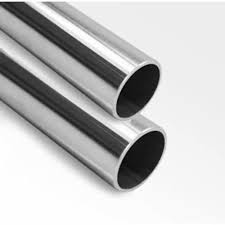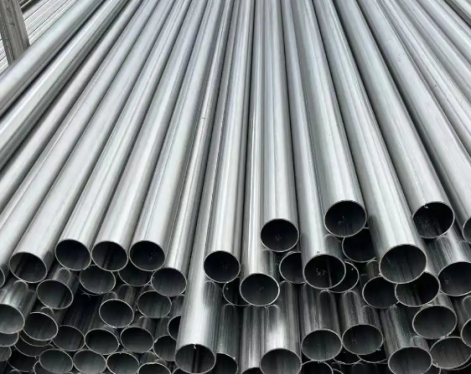1.What is a pipe schedule?
A pipe schedule refers to a standardized system used to specify the wall thickness of pipes and tubing. It is an essential aspect of pipe design and selection, providing a way to precisely communicate the thickness of a pipe's wall based on its nominal size and intended application.The schedule number – represented as "sch" followed by a numerical value such as 5, 10, 40, etc. – indicates the wall thickness of the pipe. Lower schedule numbers indicate thinner walls, while higher schedule numbers represent thicker walls. For example, a sch 40 pipe will have a thicker wall compared to a sch 10 pipe of the same nominal size.
The concept of pipe schedules is crucial for various industries, including construction, oil and gas, chemical processing, and plumbing. By adhering to standardized pipe schedules, engineers, contractors, and manufacturers can ensure that piping systems are designed and constructed with appropriate wall thicknesses to withstand the pressures, temperatures, and environmental conditions they will encounter during operation.
2.What does the S stand for in pipe schedule?
The "S" in pipe schedule designations, such as "sch 40s," typically stands for "stainless steel." When the letter "S" is included as part of the schedule number (e.g., sch 5S, sch 10S, sch 40S), it signifies that the pipe schedule is specifically designed for use with stainless steel pipes. This differentiation is important because stainless steel piping often requires specific dimensions and standards due to its unique properties and performance requirements in various industrial applications, particularly those involving corrosive or high-temperature environments. Therefore, the "S" designation helps to clearly identify schedules intended for use with stainless steel pipes, ensuring proper selection and compatibility in different piping systems. 3.Sch 40 vs sch 40s size
3.Sch 40 vs sch 40s size
In terms of size, both Sch 40 and Sch 40S pipes have the same dimensions. The "40" in their designations refers to the wall thickness of the pipe, while the nominal pipe size (NPS) and outer diameter remain the same for both types.For example, a Sch 40 or Sch 40S pipe with an NPS of 6 will have an outer diameter of 6.625 inches (168.3 mm) and a wall thickness of 0.280 inches (7.11 mm). This consistency in size allows for interchangeability in many applications, and the main difference lies in the material and the specific usage scenarios for which they are intended.
4.What is difference between sch 40 and sch 40s?
The difference between "sch 40" and "sch 40s" lies in their applications and standards:
Schedule 40 (sch 40): This designation refers to a specific thickness of a pipe wall according to the standards set by ASTM (American Society for Testing and Materials) and ASME (American Society of Mechanical Engineers). Schedule 40 pipes are commonly used in various industries, including plumbing, construction, and process piping, where moderate pressures and normal temperatures are expected.Sch 40 can be used for both seamless steel pipes and ERW (Electric Resistance Welded) pipes.
Schedule 40S (sch 40s): The "S" in Schedule 40S stands for "stainless steel." This schedule specifically applies to stainless steel pipes and is used in high-pressure and high-temperature applications, particularly in the chemical, petrochemical, and oil and gas industries. It provides the same wall thickness as standard Schedule 40 pipes, but it is specifically intended for use with stainless steel due to its unique properties and performance requirements in corrosive environments.
SCH 40 vs SCH 40S — Pipe Dimensions & Wall Thickness Table (NPS 1/8″–24″)
Notes
1.Outside diameter (OD) is the same for SCH 40 and SCH 40S for a given NPS.
2.Wall thickness for SCH 40S follows stainless steel standard (ASME B36.19M), SCH 40 follows carbon steel standard (ASME B36.10M).
3.For sizes larger than 12″, wall thickness may vary slightly depending on manufacturer or specific alloy; verify for engineering design.
4.This table covers all NPS 1/8″–24″, suitable for general reference, web content, and documentation.
In summary, while both "sch 40" and "sch 40s" refer to specific pipe schedules, the distinction lies in the materials they are designed for. "Sch 40" encompasses a range of materials for general-purpose applications, while "sch 40s" is specifically tailored for stainless steel pipes used in more demanding industrial settings.
A pipe schedule refers to a standardized system used to specify the wall thickness of pipes and tubing. It is an essential aspect of pipe design and selection, providing a way to precisely communicate the thickness of a pipe's wall based on its nominal size and intended application.The schedule number – represented as "sch" followed by a numerical value such as 5, 10, 40, etc. – indicates the wall thickness of the pipe. Lower schedule numbers indicate thinner walls, while higher schedule numbers represent thicker walls. For example, a sch 40 pipe will have a thicker wall compared to a sch 10 pipe of the same nominal size.
The concept of pipe schedules is crucial for various industries, including construction, oil and gas, chemical processing, and plumbing. By adhering to standardized pipe schedules, engineers, contractors, and manufacturers can ensure that piping systems are designed and constructed with appropriate wall thicknesses to withstand the pressures, temperatures, and environmental conditions they will encounter during operation.
2.What does the S stand for in pipe schedule?
The "S" in pipe schedule designations, such as "sch 40s," typically stands for "stainless steel." When the letter "S" is included as part of the schedule number (e.g., sch 5S, sch 10S, sch 40S), it signifies that the pipe schedule is specifically designed for use with stainless steel pipes. This differentiation is important because stainless steel piping often requires specific dimensions and standards due to its unique properties and performance requirements in various industrial applications, particularly those involving corrosive or high-temperature environments. Therefore, the "S" designation helps to clearly identify schedules intended for use with stainless steel pipes, ensuring proper selection and compatibility in different piping systems.

In terms of size, both Sch 40 and Sch 40S pipes have the same dimensions. The "40" in their designations refers to the wall thickness of the pipe, while the nominal pipe size (NPS) and outer diameter remain the same for both types.For example, a Sch 40 or Sch 40S pipe with an NPS of 6 will have an outer diameter of 6.625 inches (168.3 mm) and a wall thickness of 0.280 inches (7.11 mm). This consistency in size allows for interchangeability in many applications, and the main difference lies in the material and the specific usage scenarios for which they are intended.
4.What is difference between sch 40 and sch 40s?
The difference between "sch 40" and "sch 40s" lies in their applications and standards:
Schedule 40 (sch 40): This designation refers to a specific thickness of a pipe wall according to the standards set by ASTM (American Society for Testing and Materials) and ASME (American Society of Mechanical Engineers). Schedule 40 pipes are commonly used in various industries, including plumbing, construction, and process piping, where moderate pressures and normal temperatures are expected.Sch 40 can be used for both seamless steel pipes and ERW (Electric Resistance Welded) pipes.
Schedule 40S (sch 40s): The "S" in Schedule 40S stands for "stainless steel." This schedule specifically applies to stainless steel pipes and is used in high-pressure and high-temperature applications, particularly in the chemical, petrochemical, and oil and gas industries. It provides the same wall thickness as standard Schedule 40 pipes, but it is specifically intended for use with stainless steel due to its unique properties and performance requirements in corrosive environments.
SCH 40 vs SCH 40S — Pipe Dimensions & Wall Thickness Table (NPS 1/8″–24″)
| NPS (inch) | Outside Diameter (OD) (inch / mm) | SCH 40 Wall Thickness (inch / mm) | SCH 40S Wall Thickness (inch / mm) |
|---|---|---|---|
| 1/8″ | 0.405″ / 10.3 mm | 0.068″ / 1.73 mm | 0.068″ / 1.73 mm |
| 1/4″ | 0.540″ / 13.7 mm | 0.088″ / 2.24 mm | 0.088″ / 2.24 mm |
| 3/8″ | 0.675″ / 17.1 mm | 0.091″ / 2.31 mm | 0.091″ / 2.31 mm |
| 1/2″ | 0.840″ / 21.3 mm | 0.109″ / 2.77 mm | 0.109″ / 2.77 mm |
| 3/4″ | 1.050″ / 26.7 mm | 0.113″ / 2.87 mm | 0.113″ / 2.87 mm |
| 1″ | 1.315″ / 33.4 mm | 0.133″ / 3.38 mm | 0.133″ / 3.38 mm |
| 1¼″ | 1.660″ / 42.2 mm | 0.140″ / 3.56 mm | 0.140″ / 3.56 mm |
| 1½″ | 1.900″ / 48.3 mm | 0.145″ / 3.68 mm | 0.145″ / 3.68 mm |
| 2″ | 2.375″ / 60.3 mm | 0.154″ / 3.91 mm | 0.154″ / 3.91 mm |
| 2½″ | 2.875″ / 73.0 mm | 0.203″ / 5.16 mm | 0.203″ / 5.16 mm |
| 3″ | 3.500″ / 88.9 mm | 0.216″ / 5.49 mm | 0.216″ / 5.49 mm |
| 3½″ | 4.000″ / 101.6 mm | 0.226″ / 5.74 mm | 0.226″ / 5.74 mm |
| 4″ | 4.500″ / 114.3 mm | 0.237″ / 6.02 mm | 0.237″ / 6.02 mm |
| 5″ | 5.563″ / 141.3 mm | 0.258″ / 6.55 mm | 0.258″ / 6.55 mm |
| 6″ | 6.625″ / 168.3 mm | 0.280″ / 7.11 mm | 0.280″ / 7.11 mm |
| 8″ | 8.625″ / 219.1 mm | 0.322″ / 8.18 mm | 0.322″ / 8.18 mm |
| 10″ | 10.750″ / 273.1 mm | 0.365″ / 9.27 mm | 0.365″ / 9.27 mm |
| 12″ | 12.750″ / 323.9 mm | 0.406″ / 10.31 mm | 0.375″ / 9.53 mm |
| 14″ | 14.000″ / 355.6 mm | 0.437″ / 11.10 mm | 0.437″ / 11.10 mm |
| 16″ | 16.000″ / 406.4 mm | 0.500″ / 12.70 mm | 0.500″ / 12.70 mm |
| 18″ | 18.000″ / 457.2 mm | 0.562″ / 14.27 mm | 0.562″ / 14.27 mm |
| 20″ | 20.000″ / 508.0 mm | 0.593″ / 15.05 mm | 0.593″ / 15.05 mm |
| 22″ | 22.000″ / 558.8 mm | 0.625″ / 15.88 mm | 0.625″ / 15.88 mm |
| 24″ | 24.000″ / 609.6 mm | 0.687″ / 17.45 mm | 0.687″ / 17.45 mm |
Notes
1.Outside diameter (OD) is the same for SCH 40 and SCH 40S for a given NPS.
2.Wall thickness for SCH 40S follows stainless steel standard (ASME B36.19M), SCH 40 follows carbon steel standard (ASME B36.10M).
3.For sizes larger than 12″, wall thickness may vary slightly depending on manufacturer or specific alloy; verify for engineering design.
4.This table covers all NPS 1/8″–24″, suitable for general reference, web content, and documentation.
In summary, while both "sch 40" and "sch 40s" refer to specific pipe schedules, the distinction lies in the materials they are designed for. "Sch 40" encompasses a range of materials for general-purpose applications, while "sch 40s" is specifically tailored for stainless steel pipes used in more demanding industrial settings.
Previous:Schedule 80 galvanized pipe









